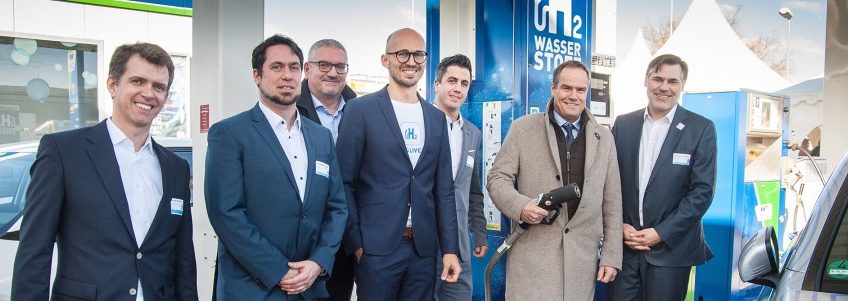H2 MOBILITY, Air Liquide and OMV open first hydrogen station in Heidelberg together with Lord Mayor Prof. Dr. Eckart Würzner Location strengthens environmentally friendly mobility in the Rhine-Neckar metropolitan region Funding by the Federal Ministry of Transport and Digital Infrastructure
Fuel-cell vehicles can now refuel in Heidelberg as well. On February 5, 2020, in the presence of Mayor Würzner, the partners H2 MOBILITY Deutschland, Air Liquide, and OMV opened the city’s first hydrogen station at Speyerer Strasse 20 in Heidelberg. The second supply point for hydrogen cars in the Rhine-Neckar metropolitan region is the station on Bergstrasse in Hirschberg, which has been in operation since 2017.
The technology for the H2 plant in Speyerer Strasse is by Air Liquide and enables the refuelling of around 40 vehicles per day. The owner and operator is the H2 MOBILITY Deutschland joint venture between the companies Air Liquide, Daimler, Linde, OMV, Shell and TOTAL have joined forces. The partners’ first goal, to be achieved in the course of 2020, is to operate 100 stations in German metropolitan areas and along major roads and motorways. Further hydrogen filling stations are to be added as the number of fuel-cell vehicles increases.
For the construction of the hydrogen station in Heidelberg, H2 MOBILITY received funding of close to 950,000 euros from the Federal Ministry of Transport and Digital Infrastructure (BMVI) through the National Innovation Programme for Hydrogen and Fuel Cell Technology (NIP).
Hydrogen-powered electromobility reduces CO2 emissions
Environmentally friendly electric mobility using hydrogen causes neither local pollutants nor CO2 emissions and offers a high level of driving convenience thanks to short refuelling times and long ranges. Fuel-cell vehicles can be refuelled in just three minutes for a range of 500 to 700 kilometres.
Professor Dr Eckart Würzner, Mayor of the City of Heidelberg:
“The opening of the hydrogen filling station in Heidelberg is an important step on our way to becoming a climate-neutral city. Fuel cells are the technology of the future. They enable emissions-free heavy goods transport, bus and long-distance traffic in the region and help ensure clean air in our cities. With the new hydrogen filling station, the city has committed itself to building a fuel-cell vehicle fleet of 30 vehicles by 2021. We are already leading by example: Our municipal vehicle fleet currently includes four cars using this technology – The first fuel-cell waste removal vehicle is to be added in 2020. All this can only work with the necessary infrastructure. That’s what we’re laying the foundations for today.”
Michael Mayer-Sonnenburg, Head of the Service Station Business, OMV Deutschland:
“Petrol stations are key contact and supply points for the mobility transition. They provide the necessary infrastructure and thus make an important contribution to the ecologically and economically sustainable mobility of the future. We believe in the long-term success of hydrogen and have therefore been committed to the infrastructure’s network expansion for a long time.”
Frédéric Minaud, Managing Director Air Liquide Advanced Technologies GmbH:
“At this point, hydrogen is one of our best solutions for achieving the goals of the Paris Climate Change Agreement. In particular, hydrogen has the potential to efficiently decarbonize the transport sector, one of the major sources of pollution in our cities. Air Liquide is proud to be involved alongside other key private and public players in building Europe’s largest hydrogen infrastructure, and thereby creating the conditions for the roll-out of fuel-cell vehicles in Germany.”
Nikolas Iwan, Managing Director H2 MOBILITY:
“H2 MOBILITY is systematically expanding the hydrogen refilling station network in Germany. After completing 100 fuelling stations in the course of the year, H2 MOBILITY will in future purposefully build where there is demand. Because zero-emissions fuel-cell passenger cars and commercial vehicles will command a significant market share worldwide and will make a major contribution to reducing emissions in traffic and transport. We are creating the conditions that will enable more and more people and companies to switch to hydrogen.”

